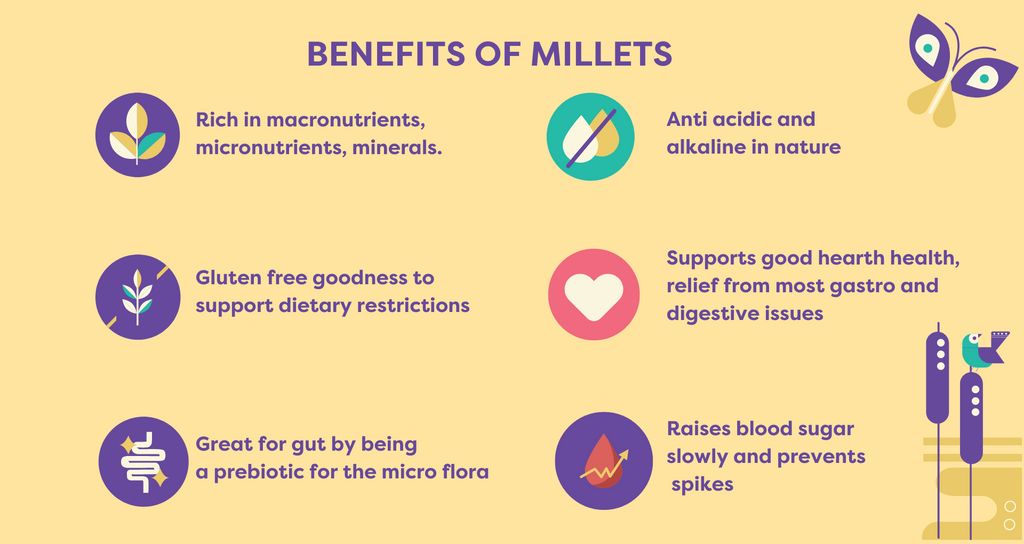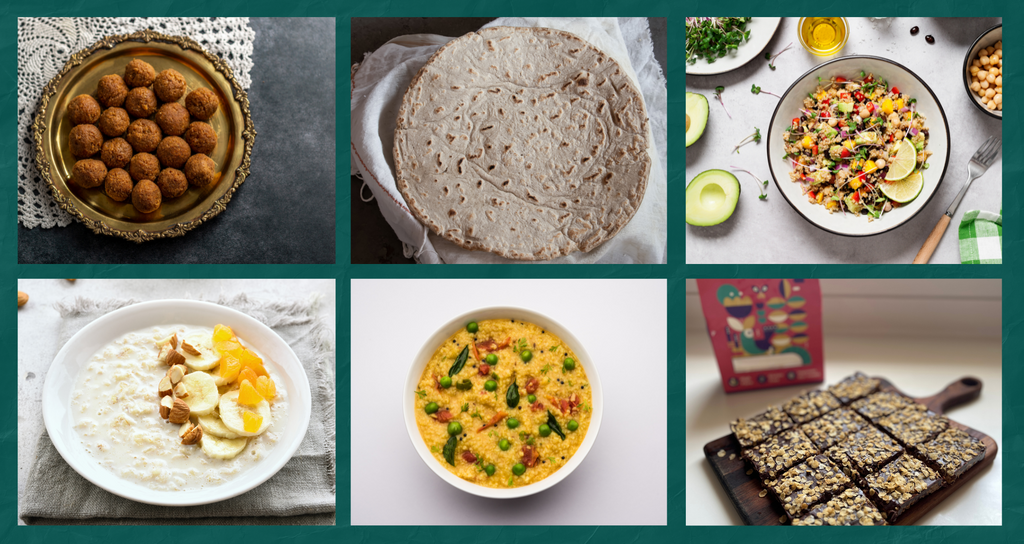A note to answer questions like what are millets, what are the benefits of millets and how you can eat millets.
When I was a kid, it would fascinate me to no end how every roti that my mom made would puff up like a balloon. Not just the regular wheat roti but also what I then referred to as ‘pitai’ wali roti meaning a roti made by patting on the dough ball continuously. I always found it amusing how mom was ‘beating’ the roti! Much later I realised it was jowar bhakri that she made this way. Then there was this blackish brown ragi laddoo that she made me have every now and then or switched it with ragi porridge which I wasn’t fond of at all! Winters meant she would make me have this nutty tasting khichdi made of bajra which I just loved.
Moving out of the house, spending fewer hours in the kitchen and more at work meant that feeding oneself became a thing of convenience and time management. Similar to the stories of many around me, I moved like a pendulum between rice and roti. Eating healthier meant eating more salads and soups and quinoa and oats. Then came this entire buzz around millets. The year 2023 was declared as the International Year of Millets. So much banter about what millets were! It took me a little time to understand that the cereals my mom would casually serve were now collectively known as millets and the world was waking up to its glory.
On one of the days, I told her in all my excitement about the many benefits of millets and how I plan to include them more often in my everyday diet. She first laughed off at me and then told me how, as expected, I would realize the goodness of something if there was an external validation and not when it came from her! Well, moms are always right!
But this made me realize how something that was such a regular thing was forgotten and people are now trying to figure out how to consume these supergrains. So here’s a quick guide on millets.
So what exactly are millets?
The grain family is pretty broad and that includes rice, wheat, oats, corn, barley along with millets. Millets, commonly addressed as cereals, have been consumed for the longest time! There has been evidence of consumption of various millets by the Harappan civilisation!!
Technically, they are small seeded grasses belonging to the botanical family Poaceae. Millets stand out due to their nutritional profile and the fact that they can grow in soils which are not optimally fertile and with lesser resources to grow. They can even withstand extreme weather conditions and survive well. They need little to no intervention in terms of fertilizers and pesticides.
Millets are largely classified as major millets and minor millets based on their grain size. There is another category called pseudo millets which do not technically belong to the Poaceae family but they are nutritionally similar and are used like the other millets or ‘true grains’.

The decline in consumption of millets:
Changing food preferences is not a simple phenomenon and has many layers of complexities to bring about a change in people’s eating habits. Something which was a regular part and parcel of people’s lives is now struggling to find its place due to various reasons.
From urbanisation and associated time constraints and affinity to convenience to agricultural priorities to social and economical standing, various factors have contributed to the decline in consumption of millets.
The Green Revolution prompted increased cultivation of wheat and rice which was further accelerated by growing urbanisation and the need to consume easy to cook and easy to carry food. Millets require some prep before they can be cooked. Food prep and cooking today, is a matter of time and convenience which is why this took a back seat.
Also, millets or unpolished or thicker grains came to be considered as the poor man’s food and the urban palate looked west for aspirational food items like oats and quinoa to meet various health goals.
Thanks to the Government of India’s attempt at revival of millets and subsequent declaration of 2023 as the International Year of Millets by the UN, millets are back in the limelight and there is so much buzz about the many benefits of millets.
So, what exactly are the benefits of millets and why are they being talked about?
Whole grains have been always considered a superior and healthy choice and millets are no exception. What also sets millet apart is that while they are sources of carbohydrates, proteins and fibre, they are a powerhouse of many micronutrients and minerals. From Vitamin B to potassium to iron to manganese, phosphorus and calcium, they are rich in many vital nutrients for the body.
Including millets in our diets is an easy way to access the many phytochemicals, minerals and micronutrients required for an optimum healthy life. The fact that millets are gluten free is a plus for many with gluten intolerance or celiac disease or just anyone looking to reduce gluten for various reasons. Millets are a good option for all age groups and can be consumed by infants to elderly folks in the house.
Millets have the ability to tolerate temperature changes, adapt to less than optimum soils, bounce back quicker than other grains in times of extreme weather conditions. They also require much lesser resources like water and pesticides to grow compared to rice and wheat and have become our answer to nutrition and food security.
According to WaterAid India’s Beneath the Surface: The State of the World's Water 2019 report, water required to grow one kg of rice is roughly 2700 litres, water required to grow 1 kg of wheat is about 1854 litres. Millets require 2.5 times lesser water to grow compared to rice. They also have shorter maturation duration of roughly 45-70 days compared to 120-140 days of rice which helps in more crop being available and evading any climatic complications. This makes them a sustainable choice in every way for human consumption.
They are rightly recognised to be good for us, good for farmers, good for nature.

How should we consume millets?
There are many ways in which millets can be added to your daily routine. Here are some ways you can have millets:
Flours - Millet flours are widely available and consumed. You can use the dough to make rotis or bread or parathas on their own or mix with wheat. Making 100% millet rotis may require some amount of practice. You can start by mixing them with wheat flour. You’d be surprised how commonly available millet flours are at supermarkets, your trusted grocery store or even the local flour mill.
You can even mix the flour to make cheelas or dosas or pancakes. You can mix flours with idli batter to make idlis too.
Flakes - If rotis is not your thing, you can try Sprouted millet flakes or poha which can be used to make poha, upma or even used as is with milk or curd of your choice! Add seasonings or flavours of your choice and get going with your day. Since the millets have been dehusked, washed and soaked and sprouted already, you can make a super quick and nutritious breakfast in just about 20 minutes
Try Sprouted Millet Flakes by Local Sparrow
Snacks - If snacking is what you enjoy, you can enjoy a range of healthy millet based snacks like chakli or popped and puffed millet (similar to popcorn), millet based laddoos and sweets or chivda.
Whole millets - On their own, whole millets can be cooked and eaten with veggies or lentils like rice or cooked to make upma or pulao like recipes. They can even be soaked and ground to make dosa and idli batters. You could use them in salads or even make delicious porridge or kheer.
However, using whole millets can seem a little tedious at the beginning and requires some planning and prep in terms of soaking, grinding etc.
There is a lot of buzz right now around millets and it may come across as just another marketing food fad but millets have been around for centuries and have a host of benefits for us. We only need to be mindful of its source, processing and consumption.
When starting off new, if you haven’t had millets before, start with a lower frequency and observe how millets make your stomach and gut feel. While millets come with a host of benefits for us, if there is a specific health concern that you are looking to address, it is always a good idea to consult a nutritionist.
Whole millets need to be washed and soaked thoroughly before being cooked or processed into flours, flakes or snacks and this is super important. Millets contain compounds which may hinder thyroid function or cause formation of kidney stones if not soaked or cooked well.
This leads to the need to ensure you source your millets and millet based products from trusted sources and choose native or heirloom variety over hybrid ones to ensure proper nutrition and absorption.

Names of millets in various Indian languages:



Comments (0)
Back to Stories and Memories